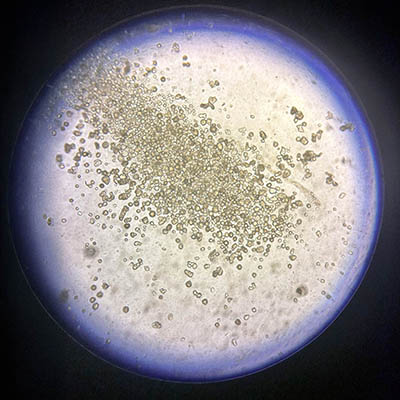Dr. Andrew Broadbent (center) discusses H5N1 avian influenza transmission with Vice President for Research Greg Ball (left), Provost Jennifer King Rice (center right), and ANSC Chair Dr. Adele Turzillo (right).
Image Credit: Jonathan Stephanoff
Drs. Andrew Broadbent and Younggeon Jin presented their Grand Challenges Team Project on November 7 to Provost Jennifer King Rice and Vice President for Research Greg Ball when they visited ANSC. The project, funded by a Grand Challenges Grant, focuses on avian influenza and involves the generation of “mini organs” known as organoids from the intestines of chickens and ducks (image below), as well as culturing cells from the respiratory tract of chickens. The team hopes to use these systems as a means to examine how avian influenza infects, replicates, spreads, and evolves in tissues from chickens and ducks, all within petri dishes, without the need to infect live birds.
 As the H5N1 avian influenza, or commonly referred to as bird flu, continues to spread within domesticated poultry, migratory waterfowl, and more recently dairy cattle, gaining a deeper understanding of how new strains of the virus emerge and evolve has significant importance. The gut of waterfowl, and gut and respiratory tracts of chicken are important points of infection and replication for the virus, but live animal research is costly and challenging. To address this, the University’s Grand Challenges Grant Program funded a team of researchers, with Dr. Andrew Broadbent as Principal Investigator, and Co-PIs Dr. Younggeon Jin and Dr. Margaret (Meg) Scull from CMNS to develop intestinal and respiratory tract cell cultures and perform infection experiments.
As the H5N1 avian influenza, or commonly referred to as bird flu, continues to spread within domesticated poultry, migratory waterfowl, and more recently dairy cattle, gaining a deeper understanding of how new strains of the virus emerge and evolve has significant importance. The gut of waterfowl, and gut and respiratory tracts of chicken are important points of infection and replication for the virus, but live animal research is costly and challenging. To address this, the University’s Grand Challenges Grant Program funded a team of researchers, with Dr. Andrew Broadbent as Principal Investigator, and Co-PIs Dr. Younggeon Jin and Dr. Margaret (Meg) Scull from CMNS to develop intestinal and respiratory tract cell cultures and perform infection experiments.
Dr. Broadbent explained the cell cultures’ usefulness, saying “the work conducted during this project will help us to reduce the number of live animals that are used in our research by replacing them with the mini-organs,” adding “this is a key component of the ‘3Rs’ (reduction, refinement, and replacement) of the use of animals in research.”
The team has since been expanded to include undergraduate and graduate students, and a laboratory technician, all who have successfully grown the cell cultures and shown that avian influenza virus can infect and replicate within them. Ongoing research includes examining which cells are first infected, how fast the virus spreads from cell-to-cell, and what immune responses occur. Future goals are to compare how different strains of the virus engage with the cell cultures and evolve.
During the Grand Challenges presentation in Dr. Broadbent’s Virology laboratory, Drs. Broadbent and Jin discussed the current progress, showed some of the organoids under a microscope, and raised some of the issues they are still working to overcome.
Considering the ongoing avian influenza spread, this new research tool has high importance and interest. Dr. Broadbent is a co-investigator on an NIH R01 grant awarded to Dr Balaji Manicassamy at the University of Iowa that aims to compare how influenza viruses bind to and enter mammalian cells compared to avian cells. The team also has a growing number of collaborations with researchers interested in using this system to study other avian diseases.
For more information about this Grand Challenges project, visit: https://research.umd.edu/aiv.